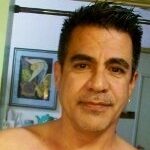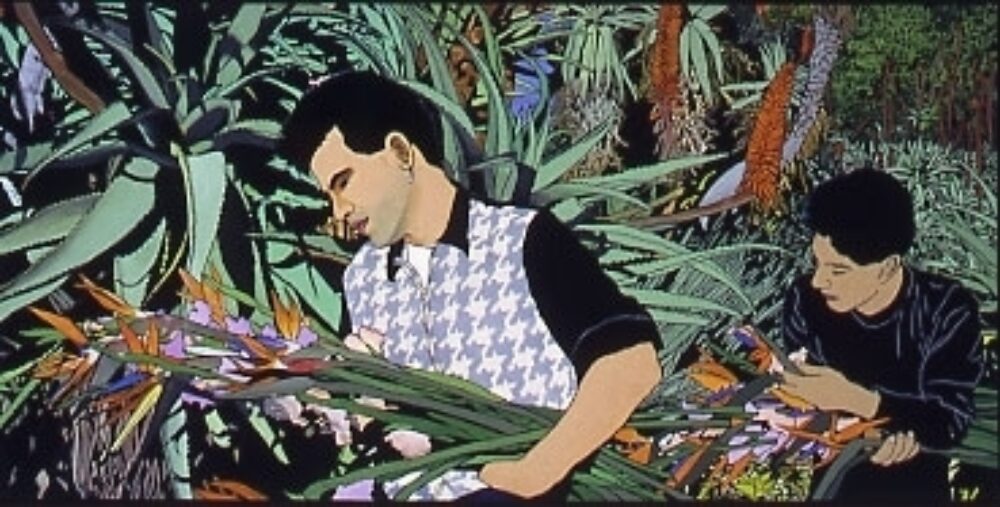
Joey Terrill’s early interest in art drew inspiration from cartoons, comics, magazines, comics, magazines, popular culture, and artistic movements of the 1950s and 1960s themes that would resonate with his artistic practice throughout his life. He studied at Cathedral High School, a private all-boys Catholic college prepatorary school, and then attended Immaculate Heart College, which in 1973 remained deeply influenced by the practices and philosophy of Sister Mary Corita Kent, who had left the college five years prior. Studying with noted feminist artist Carole Caroompas and art historian Ruth E…Terrill’s dedicated to art merged with is participation in Chicano social justice efforts and the emergent 1970s Los Angeles gay and lesbian movement. Learning about the 1969 Stonewall riots from the pages for the Los Angeles Free Press. Treffill shortly thereafter joined a lesbian and gay youth group sponsored by the Metropolitian Commmunity Church and attended the Gay Funky Dances at Troupers Hall and Larchmont Hall, where he met fellow Chicano gay artists and notable figures including Jim Aguilar, Gronk, Robert Legoretta (Cyclona), and Mundo Meza.
In 1975 Terrill exhibition worked in Escondalosas! At Hazard Gallery in the home of artist Richard Nieblas. Terrill showed two figurative screenprints titled Dormindo (featuring two sleeping men enfolded in each other’s arms) and Roberto and Joey, as well as a Kahil Gibran diary-turned cookbook to which fellow artists contributed recipes. Terrill and Teddy Sandoval met at a planning meeting for Escandalosas! and soon became close friends, collaborating on work exploring the overlap between Chicanoismo and homosexuality. At the time Terrill produced T-shirts with the words maricón and malflora (Spanish slang words for faggot and dyke), which were worn by friends marching in the 1976 Gay Pride parade on Hollywood Boulevard. In 1978 Terrill released the first issues of Homeboy Beautiful, a satirical lifestyle magazine that, with biting humor, took aim at barrio machismo and homophobia. The magazine included an advice column (“Ask Lil Loca”), beauty tips, and fashion makeovers that played with and against chola/o stereotypes. The first issue included a mock exposé on “homo-homeboys” in East Los Angeles, while the second and last issues, release in 1979, saw the homo-homeboys protest the magazine and gain self-representation on its pages. Terrill was also deeply involved in the mail art movement, as exemplified by his exchanges with Ray Johnson, whose name and address appear in both issues of Homeboy Beautiful’s “classifieds” sections.
After a brief period in New York City, where he exhibited a series of paintings, Chicanos invade New York, Terrill returned to L.A and became witness to a community reeling from the AIDS crisis. Since testing HIV-positive in 1989 Terrill’s artistic production has been intimately connected to his identity as both a Chicano HIV-positive gay man and a health educator. This has included illustrating three issues of a Spanish-language AIDS-awareness comic book titled Chicos Modernos (1989-90), which shares formal elements with Homeboy Beautiful, and a series of Pop art inspired still-life paintings in which anti-retroviral drugs and consumer products are contrasted in a critique of the pharmaceutical industry that profits from the disease. His large-scale photorealist paintings commemorate lost friends and document the history of alliances the artist cultivated with individuals both in social contexts and in queer-politicized artistic circles live VIVA, a queer Latina/o artist and AIDS-advocacy group of which he was an important part. – Richard T. Rodriguez, Axis Mundo: Queer Networks in Chicano L.A exhibition, One Archives.




























